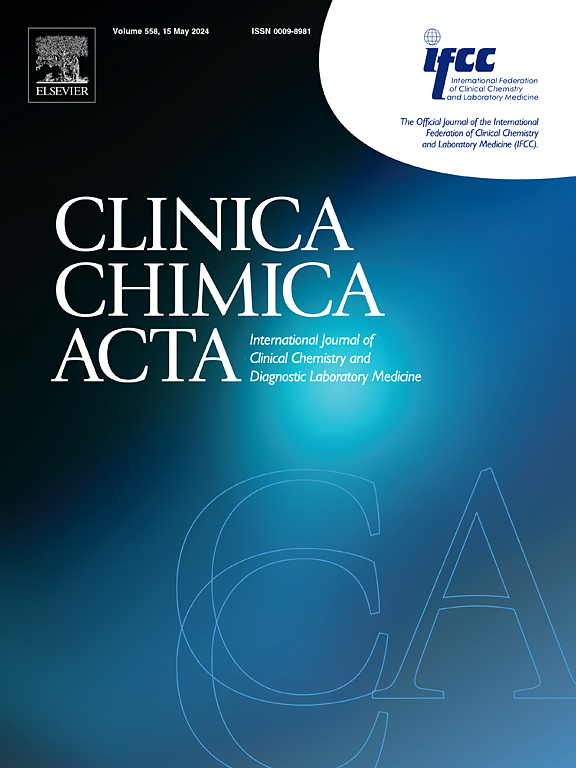新型血清采集装置 "Ser-Col "在实验室诊断感染疾病和其他几种免疫化学检验中的临床表现和应用。
IF 3.2
3区 医学
Q2 MEDICAL LABORATORY TECHNOLOGY
引用次数: 0
摘要
背景:干式采血设备可能有利于在远离医疗设施的地区和封锁状态下诊断传染病。有几份报告指出了这种应用在定性检测方面的功效。在此,我们证明了新型血清-醇采血装置作为定性和定量检测传染病标志物以及几种免疫化学检验的标准化方法的可行性:在本次研究中,我们纳入了 395 名成年参与者,其中男性 191 人,女性 204 人,中位年龄为 41 岁;以及 75 名儿童,中位年龄为 3 岁。通过检测血清样本中的三类感染性疾病(甲型肝炎和丙型肝炎、SARS-CoV-2、疱疹病毒)、抗血小板生成素、催乳素、维生素 B12 和叶酸来确定血清学状态。使用自动系统(SCAUT Ser-Col automation,Blok System Supply)和人工洗脱在 Ser-Col 设备(Labonovum)上采集的血液。Ser-Col的结果与通过标准静脉穿刺采样的血清进行了比较:用 Ser-Col 采集的血清样本与通过标准静脉穿刺采集的血清样本在以下检测项目上的相关系数很高(r = 0.95-0.99):抗-HCV、抗-SARS-CoV-2 IgG、抗-HSV-2 IgG 和抗-CMV IgM。在抗 HSV-1 IgG、CMV IgG 和抗 EBV 检测中,Ser-Col 与标准静脉穿刺血清之间的相关系数相对较低(r = 0.73-0.77)。抗血小板生成素、催乳素、维生素 B12 和叶酸的相关系数也具有高值(r = 0.97-0.99)的特点:Ser-Col与标准静脉穿刺采集的样本之间具有很高的准确性和定量相关性。因此,Ser-Col 采血器应被视为成人和儿童血液采集、储存和运输的理想替代品。本文章由计算机程序翻译,如有差异,请以英文原文为准。
Clinical performance and application of novel serum collection “Ser-Col” device in the practice of laboratory diagnosis of infection diseases and several other immunochemical tests
Background
Dried blood collection devices might be beneficial for diagnosing infectious diseases in areas far from the medical facilities and in lockdown situations. There are several reports on the efficacy of such applications for qualitative tests. Here we demonstrated the feasibility of a novel Ser-Col blood collection device as a standardized approach for qualitative and quantitative detection of infectious markers and several over immunochemical tests.
Methods
In the current study, we included 395 adult participants, 191 men and 204 women, with a median age of 41 years, as well as 75 children with a median age of 3 years. Serological status was determined by testing serum samples for three groups of infection diseases: hepatitis A and C, SARS-CoV-2, and herpes family viruses, as well as for thyroid peroxidase (TPO), prolactin, vitamin B12, and folate. Blood collected on the Ser-Col device (Labonovum) was eluted using an automated system (SCAUT Ser-Col automation, Blok System Supply) and manually. Ser-Col results were compared with serum sampled via standard venipuncture considered as the reference.
Results
High correlation coefficients (r = 0.95–0.99) were observed between serum samples collected with Ser-Col and via standard venipuncture for the following tests: anti-HCV, anti-SARS-CoV-2 IgG, anti-HSV-2 IgG, and anti-CMV IgM. Correlation coefficients between Ser-Col and standard venipuncture serum for anti-HSV-1 IgG, anti-CMV IgG, and anti-EBV tests were relatively low (r = 0.73–0.77). Correlation coefficients for anti-TPO, prolactin, vitamin B12, and folate were also characterized with high values (r = 0.97–0.99).
Conclusions
High accuracy and quantitative correlation were demonstrated between Ser-Col and samples collected by standard venipuncture. Hence, the Ser-Col blood collection device should be considered as a promising alternative for blood collection, storage, and transportation in both adult and pediatric populations.
求助全文
通过发布文献求助,成功后即可免费获取论文全文。
去求助
来源期刊

Clinica Chimica Acta
医学-医学实验技术
CiteScore
10.10
自引率
2.00%
发文量
1268
审稿时长
23 days
期刊介绍:
The Official Journal of the International Federation of Clinical Chemistry and Laboratory Medicine (IFCC)
Clinica Chimica Acta is a high-quality journal which publishes original Research Communications in the field of clinical chemistry and laboratory medicine, defined as the diagnostic application of chemistry, biochemistry, immunochemistry, biochemical aspects of hematology, toxicology, and molecular biology to the study of human disease in body fluids and cells.
The objective of the journal is to publish novel information leading to a better understanding of biological mechanisms of human diseases, their prevention, diagnosis, and patient management. Reports of an applied clinical character are also welcome. Papers concerned with normal metabolic processes or with constituents of normal cells or body fluids, such as reports of experimental or clinical studies in animals, are only considered when they are clearly and directly relevant to human disease. Evaluation of commercial products have a low priority for publication, unless they are novel or represent a technological breakthrough. Studies dealing with effects of drugs and natural products and studies dealing with the redox status in various diseases are not within the journal''s scope. Development and evaluation of novel analytical methodologies where applicable to diagnostic clinical chemistry and laboratory medicine, including point-of-care testing, and topics on laboratory management and informatics will also be considered. Studies focused on emerging diagnostic technologies and (big) data analysis procedures including digitalization, mobile Health, and artificial Intelligence applied to Laboratory Medicine are also of interest.
 求助内容:
求助内容: 应助结果提醒方式:
应助结果提醒方式:


